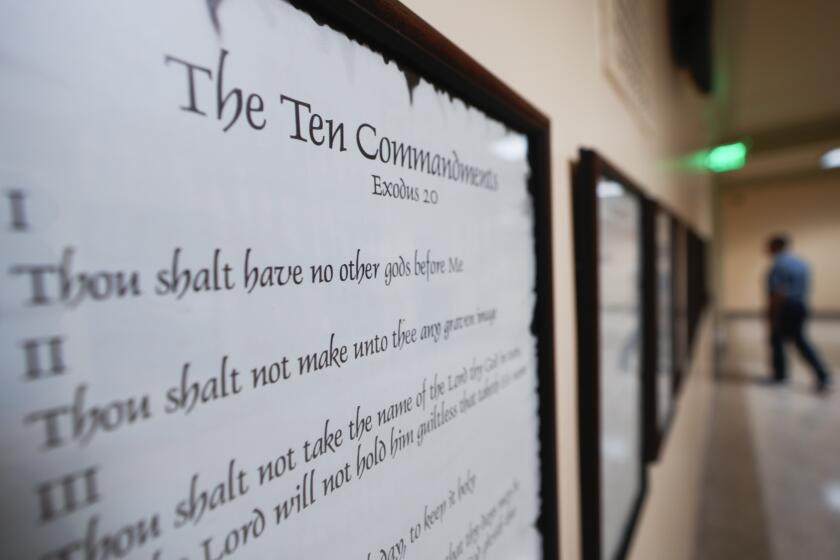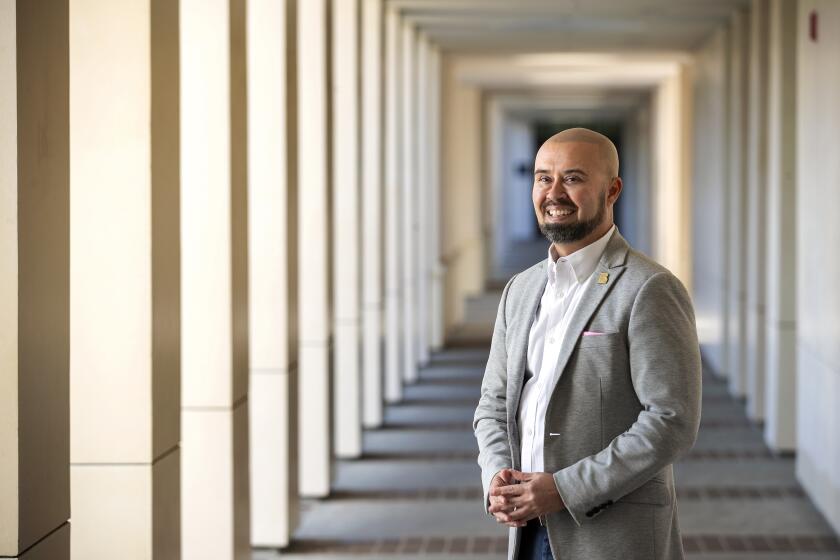Major Changes Adopted in SAT College Exam
A much-debated proposal to add a written essay as a required part of the Scholastic Aptitude Test has been rejected, College Board officials announced Wednesday.
However, the nation’s most widely used college admissions examination will undergo a major overhaul by 1994, with more emphasis on reading and less on multiple-choice questions.
The College Board decided that a written essay will replace the multiple-choice English composition achievement test, a supplemental exam required by only the most selective colleges, including the University of California. In a further response to California educators and Asian-Americans worried that an essay could penalize immigrants, students will be able to take achievement tests to show their language skills in Japanese and Chinese, as has long been the case for such languages as Spanish and French.
In other significant changes, test takers will be allowed for the first time to use calculators on the SAT math section and about 20% of the math questions will force students to come up with their solutions without hints from multiple-choice answers. Such widely detested exercises as choosing a word’s opposite meaning will be cut from the verbal section. Overall, the current two-hour SAT may be expanded by as much as 45 minutes.
The reforms are intended to make the tests more relevant to high school learning and to discourage the testing tactics that expensive coaching academies claim to teach.
“Taken as a whole, these changes are designed to send positive signals to our schools, to reinforce sound curricula in the high schools and to help in identifying the abilities and needs of a much more diverse student population,” Harvard University president Derek Bok told a crowded press conference. Bok and UC President David P. Gardner were co-chairmen of the task force that recommended the changes adopted by College Board trustees Wednesday. The College Board, a consortium of schools, sponsors the SAT.
Critics long have alleged that the SAT is biased against minorities and women and that private coaching unfairly boosts scores. College Board officials, while contesting those charges, nevertheless said they hope the revisions will ease the complaints. However, reaction around the country was mixed.
The National Center for Fair and Open Testing, a Massachusetts-based organization highly critical of the SAT, contended that the changes are cosmetic and designed as a marketing tool at a time when the number of college-age students is shrinking.
Bob Schaeffer, publication education director for the group, was particularly caustic about the College Board’s decision to rename the traditional SAT test as “SAT I” and the achievement tests, taken on a separate day, as “SAT II.”
“Renaming the Titanic the Lusitania doesn’t change the disastrous nature of things,” he said at a rival press conference in the same hotel where the College Board was holding its convention.
The new titles will make more students think they have to take both, creating an economic boon for the College Board, he said.
About 2,000 colleges and universities require or strongly recommend that applicants take the SAT. But only about 10% of those institutions--including such highly selective California schools as UC, Stanford University and Pomona College--require or recommend supplemental achievement tests.
Such schools use the achievement tests, ranging from history to science, as an added admission tool and to place students in appropriate course levels.
The Asian-American Task Force on University Admissions, a California group that alleged there may have been quotas for the numbers of Asians admitted to UC, is “very gratified” about the addition of Chinese and Japanese achievement tests, spokeswoman Kathy Owyang Turner said in a telephone interview from San Francisco. This will allow Asian-Americans to show that they are college material even if their ability to write in English is not yet up to par, she said.
Korean and Vietnamese tests may be added at a later date, College Board officials said.
UC leaders warned the College Board that adding the essay to the main SAT would produce a political firestorm, possibly forcing the UC system to drop its requirement of the SAT altogether. UC applicants now must take the SAT, or the rival and less used American College Testing program, as well as achievement tests in English composition, math and a subject the test takers choose.
In an interview at the convention, UC president Gardner conceded that objections from Californians led to the writing sample being made into an achievement test instead of part of the regular SAT.
That stand was taken, he said, because the regular SAT should measure basic aptitude, not such teachable skills as essay writing. He disputed any depiction of the essay issue as a backing away from writing. Rather, Gardner said, “treating writing as a teachable skill is a signal to high schools that writing counts.”
John Katzman, president of the Princeton Review coaching firm, said he would upgrade his rating of the SAT from a D to a D-plus because of the inclusion of more questions based on reading long texts. But he said those also could be coached. Katzman disputed Gardner’s views on the writing sample, saying it “sends the opposite message about writing” and merely reflects political fears in California.
Some educators also worry that low-income students may not be familiar with calculators and may not be able to afford even the cheap variety.
Last year, 1.75 million students took the SAT.
The SAT is a rite of passage for high school students, often dreaded for what they see as its influence on their future. But admissions officers and College Board leaders say that SAT scores are just one component of entrance decisions, along with high school grades and activities.
The SAT revisions come at a time when the test needs a shot of positive publicity. In February, 1989, a federal judge in New York ruled that the state’s use of the SAT as the exclusive criterion to award scholarships discriminated against women. Women’s scores are traditionally lower than men’s, although the test makers claim that statistic reflects high school courses taken, not bias.
The new SAT has been tested in various versions on 100,000 students over the past three years. Donald M. Stewart, College Board president, denied that the goal was to boost marketing or deflect criticism.
The major modification to the verbal section of the SAT will be adding longer reading passages and more testing of vocabulary in sentences. Questions to be answered after reading essays or sentences will increase from 40 to as many as 65. Antonyms will disappear but analogies will remain, possibly declining from 20 to 15. The number of math questions may drop from 85 to 75.
Officials said the current system of scoring each of the SAT sections on a 200-to-800 point scale will remain. The price of the basic SAT, now $16, is expected to rise as a result of the reforms. Stewart declined to quote the 1994 price, although he said the rise would be less than the rate of inflation.
More to Read
Start your day right
Sign up for Essential California for news, features and recommendations from the L.A. Times and beyond in your inbox six days a week.
You may occasionally receive promotional content from the Los Angeles Times.







